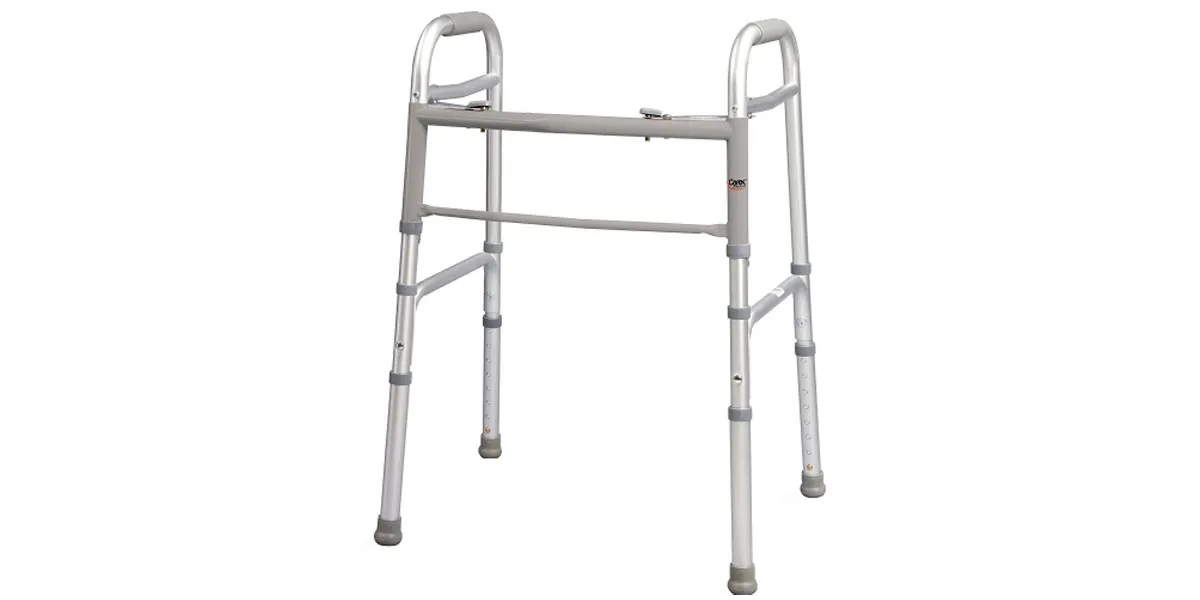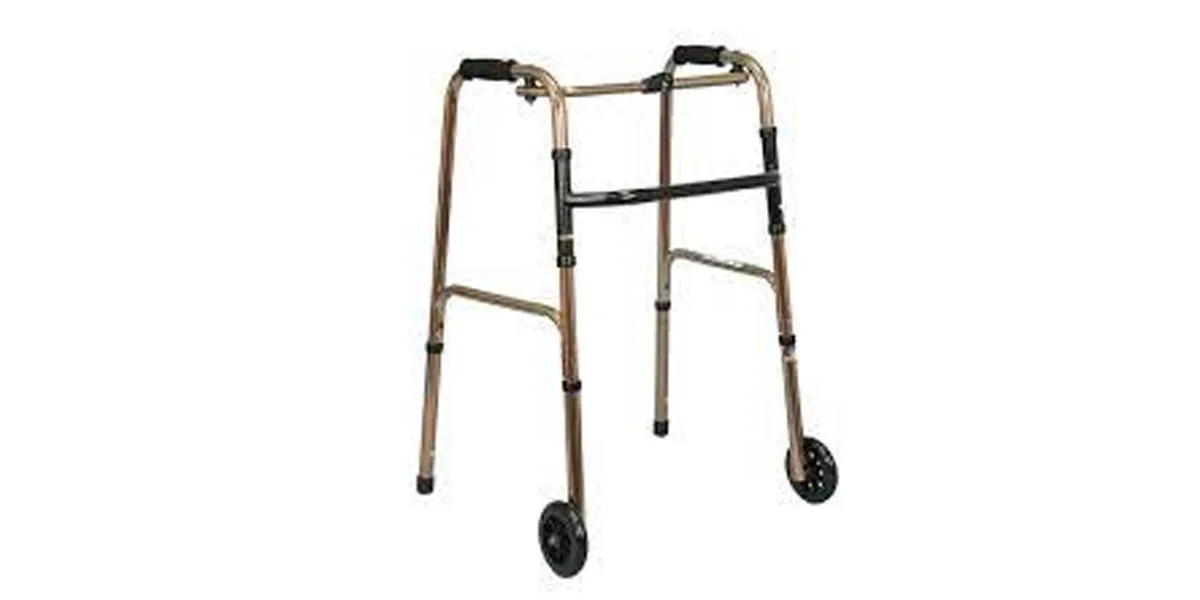Standard walkers typically range from 22 to 27 inches wide. The exact width can vary based on the model and manufacturer.
Walkers are crucial mobility aids for individuals needing extra support while walking.
Their widths are designed to accommodate most doorways in homes and medical facilities, promoting accessibility and independence for users.
Choosing the correct width is essential for maneuverability, safety, and comfort.
Users must ensure the walker is wide enough for stable support yet narrow enough to pass through their frequented spaces without issue.
Advances in walker design aim to enhance user experience, combining sturdy construction with convenience features such as foldability and adjustable height to cater to a variety of users’ needs.
Selecting an appropriately sized walker can significantly improve the quality of life for those with mobility challenges.

A Staple Mobility Aid
Walkers are vital tools for those needing extra support while walking. They help people stay active and independent.
From young adults recovering from injuries to seniors facing mobility challenges, walkers offer stability and confidence to their users.
Essential Features
Sturdy frames, comfortable grips, and adjustable height are crucial walker features. These allow for a safe and customized fit, enhancing mobility.
Safety features like lockable brakes on wheeled versions are vital for control. Here is a snapshot of essential features:
- Lightweight Construction – Ensures maneuverability without strain.
- Grip Material – Rubber or foam for comfort and non-slip security.
- Height Adjustability – Allows customization for an ergonomic fit.
- Braking System – Essential for wheeled options to maintain control.
Types And Their Uses
Different walkers serve unique mobility needs. Here’s a breakdown:
| Type of Walker | Width | Recommended Use |
|---|---|---|
| Standard Walker | 17″-27″ | Indoor use; short distances. |
| Rollator Walker | 22″-30″ | Outdoor; long distances. |
| Hemi Walker | 17″-25″ | Single-hand use; stroke recovery. |
| Knee Walker | 16″-30″ | Leg/foot injury; non-weight bearing. |
Standard walkers have no wheels, making them stable for indoor use. Rollators, with three or four wheels, offer smooth mobility outdoors.
For unique conditions such as stroke recovery, hemi walkers support one-handed use. After lower limb surgery, knee walkers are a practical alternative allowing the injured leg to rest.
Each walker type is designed with a specific width to ensure stability and ease of movement through standard doorways and narrow passages.
Users must select a walker not only by width but also by considering the specific features and intended use to support their lifestyle effectively.
Walker Dimensions Factors

Choosing the right walker isn’t just about comfort—it’s a vital part of staying safe and mobile. The width of a walker plays a critical role.
It affects your ability to move through your home and around obstacles with ease.
Standard Widths
Walkers come in various widths to cater to different body sizes and spaces. A typical adult walker ranges from 22 to 27 inches wide.
Pediatric and junior models are narrower to accommodate smaller users. A general guide is:
- Adult walkers: 22-27 inches
- Junior walkers: narrower than 22 inches
For specialized walkers, like bariatric models, widths can increase up to 30 inches or more to ensure stability for larger users.
Importance Of Proper Fit
Choosing a walker with the right dimensions is essential. A walker that’s too narrow can cause balance issues and discomfort.
Meanwhile, a walker that’s too wide can be tough to navigate through doorways and tight spaces. Consider the following points:
- Indoor navigation: Ensure the walker fits through doorways and hallways.
- User comfort: The walker should allow natural arm and hand placement.
- Mobility: Select a size that allows easy movement without strain.
Measure spaces in your living area and compare them with walker specs before making a decision.
Measuring For The Perfect Walker
Finding the right walker involves several key measurements. A walker that fits well helps users move comfortably and stay active.
Let’s dive into how to measure for the perfect walker to ensure safety and ease of use every day.
User Height And Weight
The size of a walker should match the user’s physical stature for the best support. Here are steps to find a walker that suits your height and weight:
- Stand upright with your shoes on.
- Have someone measure from the crease of your wrist to the floor.
- This measurement equals the walker’s handle height.
Most walkers come with a weight capacity. Ensure the product supports your weight for maximum reliability.
Doorways And Living Spaces
A walker must easily navigate within your living spaces.
Measure doorways to ensure the walker fits. Do this for all rooms you frequently use.
Consider the layout of your home. Note any narrow corridors or sharp turns. Choose a walker that maneuvers these spaces with ease.
The perfect walker should:
- Pass through doorways without folding.
- Turn in hallways without hassle.
- Store easily in your living space.
| Living Space | Minimum Walker Width |
|---|---|
| Doorways | 28 inches |
| Corridors | 30 inches |
| Room to Maneuver | 36 inches |
Remember, every home and individual is unique. Take these measurements to find a walker that enhances your mobility and integrates seamlessly into your daily life.
Adjusting Your Walker: Tips And Tricks

Adjusting your walker is key to ensuring both comfort and safety. While walkers come in various dimensions, tailoring them to your personal needs can make all the difference.
Discover these simple yet effective tips and tricks to get your walking aid fitted just right for you.
Height Adjustments
Getting the height right prevents strain on your arms and shoulders. Stand tall with your arms at your sides, then adjust the walker so the handles line up with your wrists. Here’s how to do it:
- Locate the height adjustment buttons on the walker’s legs.
- Push the buttons and slide the leg up or down to the desired height.
- Ensure all legs are locked in place and at the same height for stability.
Width Adjustments
The right width allows easy maneuvering through doors and hallways. For bariatric walkers or those with extra features, width adjustments might be available. To alter the width:
- Consult the manual for your specific walker model.
- Some models have adjustable sides; push buttons to widen or narrow.
- Check that the walker fits through your most frequented spaces.
Always test your adjusted walker in a safe environment before regular use. Correct adjustments can improve your mobility and maintain your independence.
Choosing The Right Walker Model
When it’s time to pick out a walker, size matters a lot. A walker that’s too wide can be tough to handle. Too narrow, and it might not be super steady. We need to think about different places it will go.
Heavy-duty Options
Walkers built for extra support are wider. This makes them stable and safe. Here’s what to consider with heavy-duty models:
- Weight capacity: They can hold more weight.
- Frame width: They have a sturdy frame for balance.
- Adjustable handles: This makes them comfy for any height.
Space-saving Designs
Slim walkers fit tight spots. Perfect for small homes and shops. Here’s the scoop on space-savers:
- Foldable: They tuck away when not used.
- Narrow frame: They slip through doors so easy.
- Lightweight: They’re not heavy, so moving them is a snap.
Outdoor-friendly Features
For the adventure seekers, you need a walker that can handle the outdoors. Look for these outdoor-ready traits:
- Durable tires: Big and strong tires for rough paths.
- Adjustable height: Customize it for comfort on uneven ground.
- Extra grip handles: They help you hold on tight, even if it’s damp.
Maintaining Your Walker
Walkers help with stability, but they need care too. Just like any commonly used item, a walker requires regular maintenance.
This ensures it stays clean and works well for as long as possible. Remember, a well-maintained walker means a safer walking experience.
Let’s dive into how to keep your walker in top shape.
Regular Cleaning
Cleaning your walker keeps it hygienic and functioning smoothly. Here’s what to do:
- Use mild soap and water to wipe down handles and frame.
- Dry thoroughly to prevent rust on metal parts.
- Clean the wheels to remove any debris that may cause drag.
Checking For Wear And Tear
Regular checks can prevent accidents. Follow these steps:
- Inspect the grips for rips or slipping.
- Look at the wheels for wobbly movement or uneven wear.
- Check for loose parts and tighten them.
A walker supports daily activities, so give it the care it deserves.
FAQs About the Width of Walkers
What’s The Average Width Of A Walker?
The average width of a walker typically ranges from 22 to 27 inches, accommodating various doorways and user sizes.
What Is A Standard Walker?
A standard walker is a mobility aid with four legs and a lightweight frame that users grip and lift to move forward.
It provides stability and support for individuals who have difficulty walking.
What Size Is A Adult Walker?
Adult walkers typically have adjustable heights ranging from 32 to 39 inches to accommodate various user statures.
Standard walkers are around 22 inches wide to allow for comfortable maneuvering.
How Wide Is A Hospital Walker?
Hospital walkers typically range from 17 to 28 inches in width, accommodating different doorways and patient sizes.
Conclusion
Selecting the right walker width is essential for both comfort and mobility. Ensure the model you choose fits through doorways and hallways in your living space.
Remember, a balance between snug support and ample room is key.
Measure wisely, and you’ll find a walker that enhances your daily routine seamlessly.
